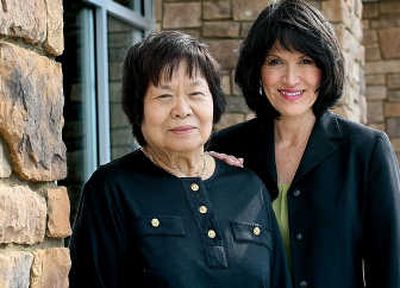Hanford manager, mother plan emotional Nagasaki trip

RICHLAND – In 1945, workers at a remote, top-secret reactor built amid Washington’s windblown sagebrush produced plutonium for a bomb to be dropped on Japan.
On the other side of the world, 15-year-old Kazuko Ozaki narrowly missed the atomic bomb that destroyed Nagasaki that August, effectively ending World War II.
Decades later, Ozaki’s daughter, Shirley Olinger, is a nuclear engineer overseeing cleanup at the highly contaminated Hanford Nuclear Reservation.
The pair are returning to Nagasaki today.
“I’m very aware of the legacy of the war here in this country, and I’d like to learn the legacy of the war there,” Olinger said. “I want to get their point of view.”
On Aug. 6, 1945, the U.S. bomber Enola Gay dropped the “Little Boy” bomb on Hiroshima. Three days later the B-29 Bock’s Car dropped a bomb dubbed “Fat Man” on Nagasaki, with plutonium from the remote Hanford Nuclear Reservation. Estimates of the death toll exceeded 200,000.
Ozaki had forsaken her annual visit to her grandmother in Nagasaki because regular U.S. bombing runs across Japan had made travel too dangerous. Instead, she remained in Okiyama, near Hiroshima, with her father, a contractor for the Japanese military.
“We were so shocked, so concerned, so worried,” Ozaki said, recalling news of the bomb blasts. Two weeks went by before they learned her grandmother had survived in her home outside of Nagasaki. However, her best friend, who had been working in the city, was among the dead.
“Aren’t you glad you’re not?” she recalled her father saying.
Twelve years later, Ozaki married a U.S. sailor, Frank Olinger, during the occupation of Japan, gave birth to a girl and moved to the United States. They led a military life, setting up house in Kansas, Washington, California and Hawaii.
At Pearl Harbor, Olinger recalls hanging around the shipyards, saying goodbye to her father each time his submarine left for sea. She went on to be a civil engineer for the U.S. Forest Service, building bridges in the Willamette National Forest, before returning to Hawaii.
She trained as a nuclear engineer at the same Pearl Harbor Naval Shipyard where she had visited her father. She met her husband, a fellow engineer, and they moved to Washington, D.C., where they began working for the U.S. Department of Energy.
Nuclear waste cleanup became their focus. Stops in Savannah River, S.C., and Rocky Flats, Colo., followed.
“We did such a good job we kind of worked ourselves out of a good job,” Olinger said of Rocky Flats, the Energy Department’s former weapons site that has been cleaned up and is now closed. “But that’s a good thing.”
Hanford, then, sounded like a neat experience with a similar cleanup mission, she said.
After decades of plutonium production for the nation’s nuclear weapons arsenal, Hanford is the nation’s most contaminated nuclear site. Cleanup costs are expected to top $60 billion.
The couple moved to south central Washington in 2001.
“When I found out where the building was that created that original plutonium …” Olinger’s voice trailed off, as she smiled and shivered goose-bumps. “I felt like this must be meant to be. I’m here for a real purpose.”
Last fall, the Energy Department named Olinger manager of its Office of River Protection, one of two top jobs at Hanford, overseeing removal of tank waste and construction of a massive plant to treat it.
About 53 million gallons of radioactive and hazardous waste – enough to cover 123 football fields, including end zones, a foot deep – are stewing in 177 underground tanks, some of which have leaked into the aquifer and threaten the Columbia River.
Waste removal has proven difficult, and the $12 billion plant under construction to encase the waste in glasslike logs for long-term storage has experienced numerous delays. But Olinger is optimistic the cleanup projects are back on track. “It’s baby steps. Nothing can be done in great leaps.”
Olinger and her mother, now 79, have each been back to Japan, but her mother hasn’t been to Nagasaki for 37 years.
Her husband and two children also are making the trip. All will visit the Nagasaki Atomic Bomb Museum – Olinger plans to leave a Hanford item for the museum – as well as a cousin and his family, who had previously visited Pearl Harbor.
“They were so apologetic. They were crying,” Olinger said of her relatives. At the same time, they harbor no ill will toward the United States.
“War is war. That’s what they say,” Olinger said. “There’s no bitterness.”